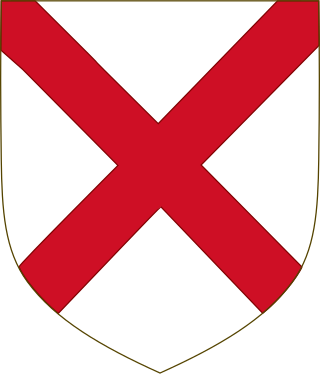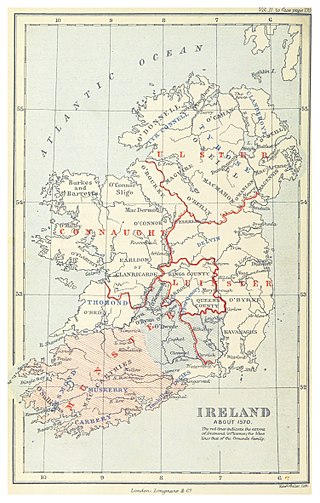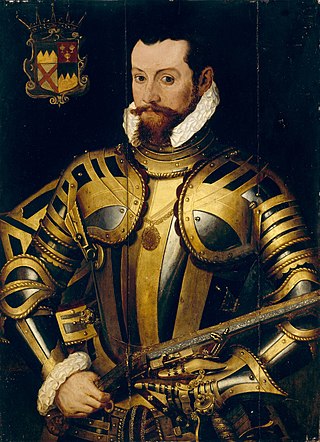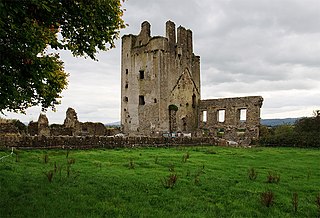Related Research Articles

Earl of Desmond is a title in the peerage of Ireland which has been created four times since 1329. The title was first awarded to Maurice FitzGerald, 4th Baron Desmond, a Hiberno-Norman lord in Southwest Ireland, and it was held by his descendants until 1583 when they rose against the English crown in the Desmond Rebellions. Following two short-lived recreations of the title in the early 1600s, the title has been held since 1628 by the Feilding family of Warwickshire, England. The current holder is Alexander Feilding, 12th Earl of Denbigh and 11th Earl of Desmond.

The FitzGerald dynasty is a noble and aristocratic dynasty of Cambro-Norman and Anglo-Norman origin. They have been peers of Ireland since at least the 13th century, and are described in the Annals of the Four Masters as having become "more Irish than the Irish themselves" or Gaels, due to assimilation with the native Gaelic aristocratic and popular culture. The dynasty has also been referred to as the Geraldines and Ireland's largest landowners. They achieved power through the conquest of large swathes of Irish territory by the sons and grandsons of Gerald de Windsor. Gerald de Windsor was the first Castellan of Pembroke Castle in Wales, and became the male progenitor of the FitzMaurice and FitzGerald Dynasty. His father, Baron Walter FitzOther, was the first Constable and Governor of Windsor Castle for William the Conqueror, and was the Lord of 38 manors in England, making the FitzGeralds one of the "service families" on whom the King relied for his survival.

The Desmond Rebellions occurred in 1569–1573 and 1579–1583 in the Irish province of Munster. They were rebellions by the Earl of Desmond, the head of the FitzGerald dynasty in Munster, and his followers, the Geraldines and their allies, against the threat of the extension of the English government over the province. The rebellions were motivated primarily by the desire to maintain the independence of feudal lords from their monarch but also had an element of religious antagonism between Catholic Geraldines and the Protestant English state. They culminated in the destruction of the Desmond dynasty and the plantation or colonisation of Munster with English Protestant settlers. 'Desmond' is the Anglicisation of the Irish Deasmumhain, meaning 'South Munster'.

Thomas Butler, 10th Earl of Ormond and 3rd Earl of OssoryPC (Ire), was an influential courtier in London at the court of Elizabeth I. He was Lord Treasurer of Ireland from 1559 to his death. He fought for the crown in the Rough Wooing, the Desmond Rebellions, and Tyrone's Rebellion. He fought his rival, Gerald FitzGerald, 14th Earl of Desmond in the Battle of Affane in 1565.

Gerald FitzGerald, 14th Earl of Desmond, also counted as 15th or 16th, owned large part of the Irish province of Munster. In 1565 he fought the private Battle of Affane against his neighbours, the Butlers. After this, he was for some time detained in the Tower of London. Though the First Desmond Rebellion took place in his absence, he led the Second Desmond Rebellion from 1579 to his death and was therefore called the Rebel Earl. He was attainted in 1582 and went into hiding but was hunted down and killed.
James FitzGerald or James Fitzgerald may refer to:
James fitz Maurice FitzGerald, called "fitz Maurice", was a native Irish and Anglo-Norman captain-general of Desmond while Gerald FitzGerald, 14th Earl of Desmond, was detained in England by Queen Elizabeth after the Battle of Affane in 1565. He led the first Desmond Rebellion in 1569 and was sometimes called the "Archtraitor" by the English. He surrendered in 1573, prostrating himself in Kilmallock church before John Perrot, president of Munster.
Edmund Fitzgibbon, 11th White Knight, was an Irish nobleman of the FitzGerald dynasty, who held a Hiberno-Norman hereditary knighthood. His loyalty to Elizabeth I resulted in the capture of his kinsman, the self-declared 16th Earl of Desmond, James FitzThomas FitzGerald.
John Fitzedmund Fitzgerald was the hereditary Seneschal of Imokilly, an Irish nobleman of the Welsh-Norman FitzGerald dynasty in the province of Munster, who rebelled against the crown during the reign of Queen Elizabeth I of England.

The Battle of Affane was fought in County Waterford, in south-eastern Ireland, in 1565, between the forces of the Fitzgerald Earl of Desmond and the Butler Earl of Ormond. The battle ended in the rout of the Desmond forces. It was one of the last private battles fought in Britain or Ireland.
The Second Desmond Rebellion (1579–1583) was the more widespread and bloody of the two Desmond Rebellions in Ireland launched by the FitzGerald Dynasty of Desmond in Munster against English rule. The second rebellion began in July 1579 when James FitzMaurice FitzGerald landed in Ireland with a force of Papal troops, triggering an insurrection across the south of Ireland on the part of the Desmond dynasty, their allies, and others who were dissatisfied for various reasons with English government of the country. The rebellion ended with the 1583 death of Gerald FitzGerald, 14th Earl of Desmond, and the defeat of the rebels.
Events from the year 1589 in Ireland.
James FitzEustace of Harristown, 3rd Viscount Baltinglass (1530–1585) James FitzEustace, the eldest son of Rowland Eustace, 2nd Viscount Baltinglass and Joan, daughter of James Butler, 8th Baron Dunboyne. He was born in 1530 and died in Spain in 1585. Baltinglass's family was traditionally associated with the FitzGerald family, the earls of Kildare, but prudently remained loyal to Henry VIII during the "Silken Thomas" Rebellion of 1534–35. For their loyalty, they were granted additional lands. Later in the 1540s Thomas FitzEustace, James's grandfather, was created first Viscount Baltinglass by a grateful king. But like many other old English Pale families, the FitzEustaces later became disillusioned.
Connor O'Brien, 3rd Earl of Thomond also spelt Conor and called Groibleach, or the "long-nailed", fought his uncle Donnell over his father's succession during thirty years from 1535 to 1565. He was confirmed as 3rd Earl of Thomond in 1558 by the Lord Deputy of Ireland, Thomas Radclyffe, 3rd Earl of Sussex. O'Brien intrigued with fitz Maurice in 1569 during the 1st Desmond Rebellion and fled to France. He returned and was pardoned in 1571, being restored to his lands at the end of the rebellion in 1573.
Sir Thomas Norris (1556–1599) was an English soldier. He sat in the Irish House of Commons, and was made Lord President of Munster in Ireland. His last name is sometimes spelt Norreys.

John Butler of Kilcash was an Irish landowner and soldier. A younger son of James Butler, 9th Earl of Ormond and brother of Thomas Butler, 10th Earl of Ormond, he received Kilcash Castle as appanage. He fought in the Desmond–Ormond conflict and was badly wounded in 1563, just before the Battle of Affane. He was the start-point of the Kilcash branch of the Ormonds and the father of Walter Butler, 11th Earl of Ormond.

James FitzGerald, 6th Earl of Desmond, called 'the Usurper', was a younger son of Gerald FitzGerald, 3rd Earl of Desmond, and Lady Eleanor, daughter of James Butler, 2nd Earl of Ormond.

Barnaby Fitzpatrick, 2nd Baron Upper Ossory, was educated at the court of Henry VIII of England with Edward, Prince of Wales. While he was in France, he corresponded regularly with King Edward VI. He was active in suppressing Wyatt's rebellion in 1553. He went home to Ireland, where he would have a lifelong feud with the Earl of Ormonde. His wife and daughter were abducted in 1573 by the Grace family, supposedly at Ormonde's instigation. He killed his cousin, the rebel Rory O'More in 1578.

James fitz John FitzGerald, 13th Earl of Desmond, also counted as the 14th, ruled 22 years, the first 4 years as de facto earl until the death of James FitzGerald, de jure 12th Earl of Desmond, called Court Page, who was murdered by James fitz John's brother Maurice fitz John FitzGerald, called Totane. James fitz John FitzGerald maintained himself in power by skilful diplomacy, avoiding armed conflict and destruction. He was appointed Lord Treasurer of Ireland in 1547.
Thomas Fitzmaurice, 16th Baron Kerry and Baron Lixnaw (1502–1590) was an Irish nobleman, politician, and peer.
References
- Attribution
 This article incorporates text from a publication now in the public domain : Dunlop, Robert (1889). "Fitzgerald, John Fitzedmund (d.1589)". In Stephen, Leslie (ed.). Dictionary of National Biography . Vol. 19. London: Smith, Elder & Co. pp. 131–132.; Endnotes:
This article incorporates text from a publication now in the public domain : Dunlop, Robert (1889). "Fitzgerald, John Fitzedmund (d.1589)". In Stephen, Leslie (ed.). Dictionary of National Biography . Vol. 19. London: Smith, Elder & Co. pp. 131–132.; Endnotes: - The principal references to Fitzgerald's life contained in the State Papers will be found in the Unpublished Geraldine Documents, edited by Hayman and Graves, part ii. pages 1 18–36.